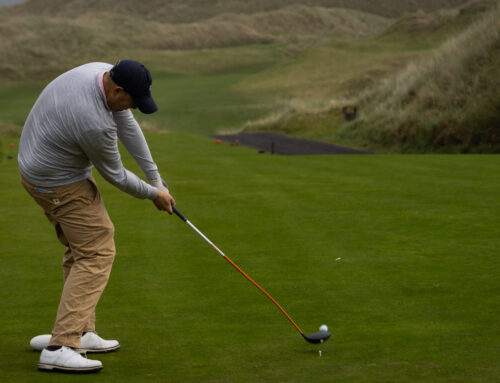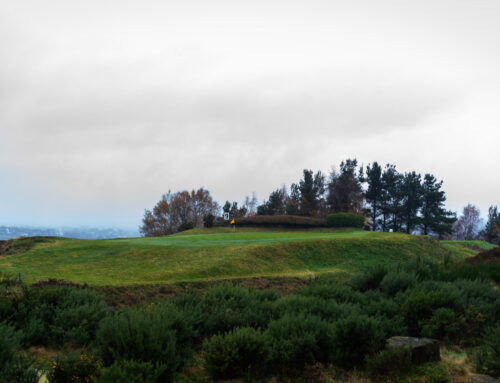“I think the golf course is amazing. It’s probably one of the most beautiful golf courses I’ve ever seen, if not the most.” – Jon Rahm
I’ve often heard that Portstewart Golf Club is a ‘hidden gem’. Yet having had the privilege to play at this magnificent golf course twice this year, there is absolutely nothing ‘hidden’ about it. Sam’s feeling that it was miles away from Portrush may be a common misconception, however in reality it is a mere 10 minute drive up the road. Indeed, it’s one vertex of the colloquially known ‘Triangle’ – made up of Portrush, Portstewart and Coleraine.
For us, the journey to Portstewart Golf Club was a quick hop across the county border from Portrush into County Londonderry, an area replete with holiday homes and hugely popular with visitors, surfers and golfers throughout the year.
The arrival at Portstewart is nothing short of breath-taking. The panorama that you are presented with as you sit down amongst the members is one of the most dramatic in world golf. Looking out towards the West and County Donegal, you see the first hole and a crashing dunescape that makes you feel very small indeed. It’s a jaw to the floor moment as you try and take it all in. The first hole of the Strand, with its towering dunes framing it, beckons you from the comfort and warm of the clubhouse.

Take in the drama of the 1st at Portstewart.
It’s important to highlight the history of the Strand Course at Portstewart, for it is a fascinating story. Not the original course of the town (that is the Old on the east of the town), the Strand opened in 1908, fourteen years after the Club’s inception. Originally laid out by AG Gow, the head professional at neighbouring Portrush, the course sat on land known as ‘Strand Head’. Just over a decade later, the prolific Willie Park Jnr firmly stamped his mark on the layout and conducted his own thorough makeover of the course.
However, most fascinatingly, the course was significantly altered in 1986, when local maths teacher Des Giffin, designed the present layout upon newly purchased land known as ‘Thistly Hollow’. He was also responsible for the opening of the Riverside course, a nine-hole layout on the banks of the River Bann, which has since been extended to 18. For a Club that is so closely connected with the town and the community, it is so apt that such a spectacular course was laid out by one of the locals. I’m sure we would all enjoy Mr Giffin’s golf-themed maths lessons.
Mr Giffin, laid out this magnificent links through duneland he explored as a child. He was very proud to witness the Irish Open on his course in 2017 and was especially excited to see compatriot Rory McIlroy tee it up. He no doubt also passed on great golfing wisdom to two of his pupils: Ricky Elliot and Graeme McDowell, both of course having been involved in winning golf’s greatest prizes.
It is no myth that the front nine, which meanders its way through the ‘Brobdingnagian’ Dunes, is amongst the very best in the world. The first, a 427 yard dog-leg par 4, provides instant theatre and is simply one of the best opening holes in links golf. With trouble on the left, the rolling waves of the Atlantic on the right, and the gaze of the clubhouse behind you, you’ll be forgiven for feeling a little nervous. The second follows suit, fiendishly named ‘Devil’s Hill’, and plays around the back of that enormous dune and up towards a wickedly small green tucked into the side of the slope.

The 2nd: Devil’s Hill
Perhaps a cliché, but the Irish tend to do everything ‘amateur’ in an incredibly professional way. Whether it is provincial sport or golf course architecture, it is always to a remarkable standard. The work of Pat Ruddy springs to mind, being a competitive amateur in his own right, he of course went on to design many a renowned course and write about the game extensively. Giffin clearly had a gift, because the holes that follow on the front nine are mesmerisingly good. The 5th, ‘Rifle Range’ and the hardest hole on the card, has a green complex parcelled behind two sweeping dunes and that is certainly reminiscent of the 2nd at Royal County Down.

The green at the 5th.
There’s not a weak hole, with the 6th ‘Five Penny Piece’ a short three and the 8th ‘Portnahapple’ a unique dog-leg par four with a shelved fairway two that particularly stand out in the memory.
A lot has been made about the contrast between the two nines at Portstewart, with the apparent consensus that the back nine is a big disappointment. Admittedly, after playing the course for the first time in May, I fell into this trap – telling both Sam and Tom that I didn’t remember it being ‘all that’.
There is no denying that, sat on a much flatter portion of land by the river, it lacks the same stupefying scenery, yet the layout and quality of holes is certainly on par and not to be overlooked. Featuring two great par threes and the brilliant risk-reward par five 14th, the Strand remains compelling throughout. False fronts, run-offs, networks of bunkers all combine to create a proper experience of links golf. For Tom, the standout hole was the 17th, a hole written off by many who have written about it. But at 446 yards, with a green sat above a punishing false front, it’s a brutal golf hole that can test the very best ball strikers.
The homeward nine is classic links golf but perhaps just a victim of the front nine’s magnetism. It was an interesting talking point throughout the day, about how one’s opinion of golf holes is affected by the ‘status quo’ opinion or hearsay. We received numerous messages on our social media along the lines of ‘what a front nine’, which in addition to my lack of strong memories of the back nine, seemed to lower Sam and Tom’s expectations.
Additionally, it’s interesting to question whether courses which have such juxtaposed land are always going to be more susceptible to criticism. Simply, with such a dramatic landscape on the outward nine, is the back nine always going to feel slightly flat? I’ve heard similar things about Royal Aberdeen. On second playing for me personally, I appreciated the layout of the back nine exponentially more.
For Tom and Sam, the entire experience trumped expectations, with the back nine ultimately being a truly stern test of golf and much more than what was in their collective imagination.

Risk Reward: Several of Portstewart’s tee shots offer aggressive angles over the corners of dunes.
However, playing host to the 2017 Irish Open, which was won in style by none other than Jon Rahm, there is no doubt about the Strand’s status as a fantastic championship golf course that more than holds its own against its esteemed and distinguished neighbour.
With exciting plans to enhance the layout by European Golf Design, the Strand will only continue to be a must-see course in Northern Ireland. Moreover, never write off the second (and third) course. Whilst we had to whisk ourselves away to the airport, both the Riverside and the Old look like exceptional playgrounds of golfing pleasure.
Above all, however, Portstewart’s welcoming atmosphere, and sense that it is the ‘Club of the Town’ is what struck me most. The members are immensely proud of their Club, its heritage and its links with the town. Vibrant and bustling, the clubhouse is a fun place to hang out and is certified pure.
If you finish your round at Portstewart and cap it off with a visit to the Harbour Bar, you’re certainly in for a day of days.





